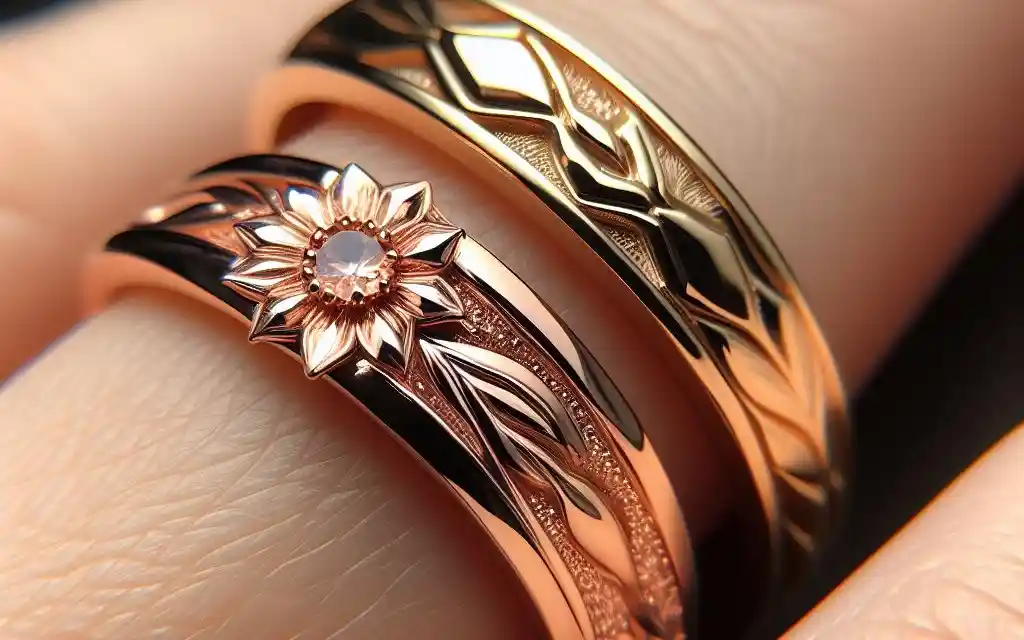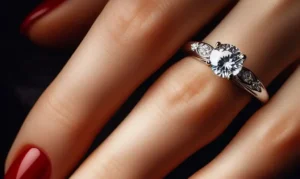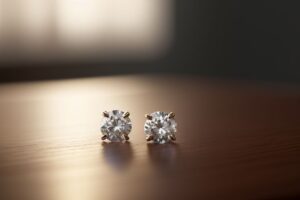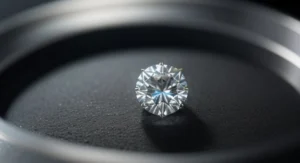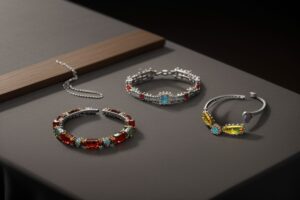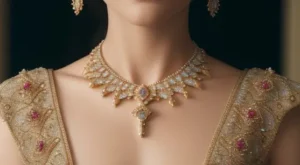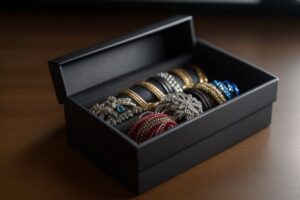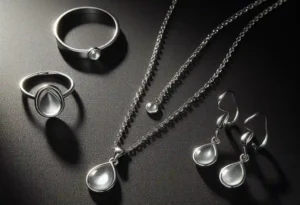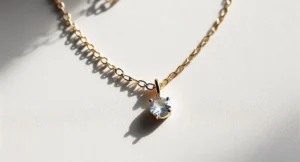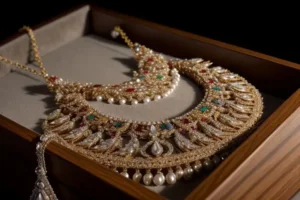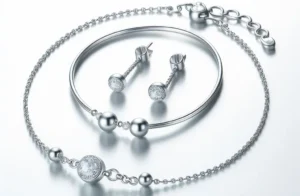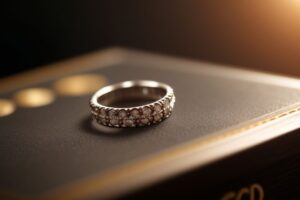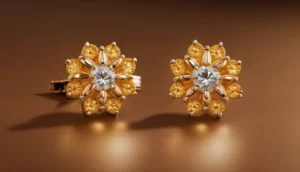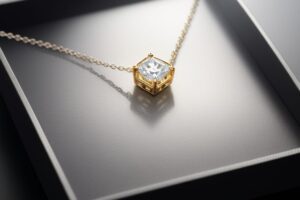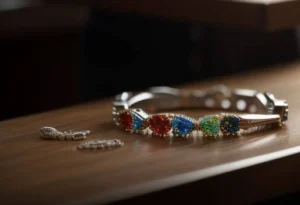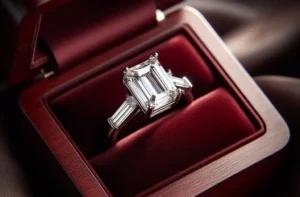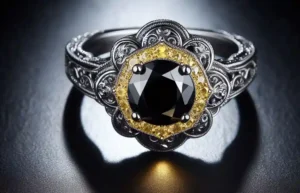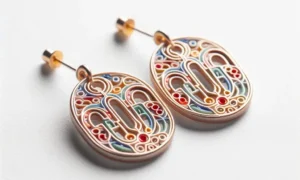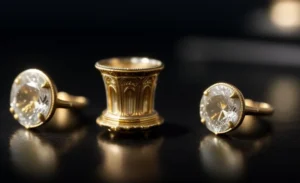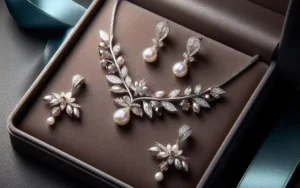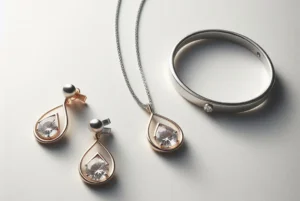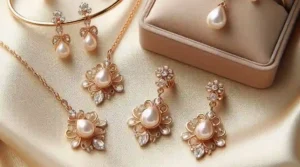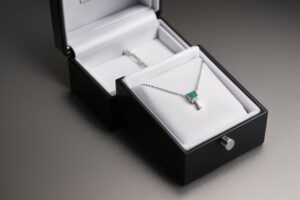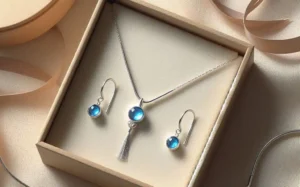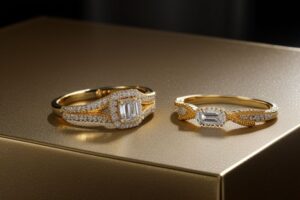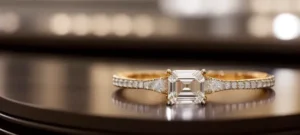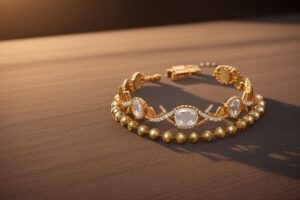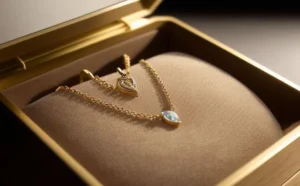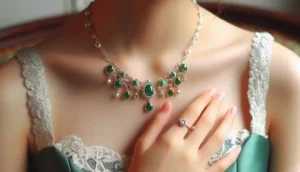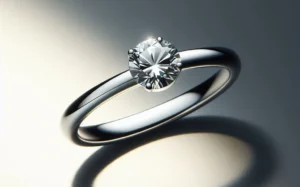10k vs 14k Rose Gold: Rose gold has risen in popularity over the past few years, captivating many with its warm, blush tones that offer a unique alternative to the traditional yellow and white gold.
Each has its advantages and peculiarities, which can make choosing between them a bit of a challenge. Let’s explore the differences between 10k and 14k rose gold to help you make an informed decision.
Understanding the Basics of Rose Gold
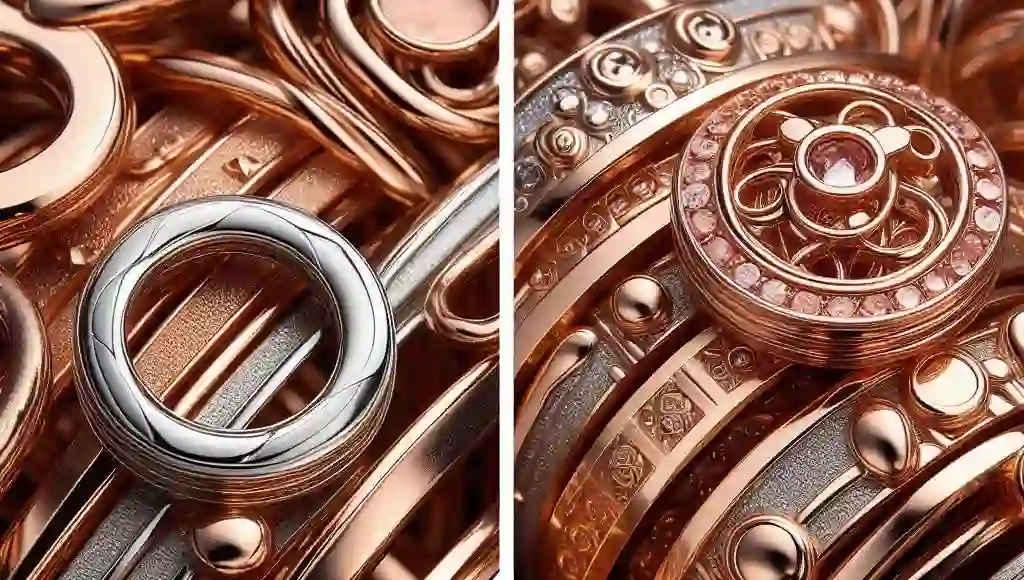
Rose gold’s unique charm lies in its composition, an alloy blending pure gold with copper, and occasionally, a touch of silver. This mix not only contributes to its signature pink hue but also influences the properties of the final alloy.
The term “karat” measures the purity of the gold within this blend, with pure gold defined as 24 karats. In this context, 10k rose gold comprises 41.7% gold, with the remainder being primarily copper, resulting in a durable and more affordable option.
On the other hand, 14k rose gold contains 58.3% gold, offering a richer color and a slightly softer composition due to its higher gold content.
This fundamental understanding of rose gold’s makeup is crucial for appreciating the nuances between the 10k and 14k varieties, each tailored to different preferences and uses in jewelry making.
Pros And Cons Of 10k Rose Gold
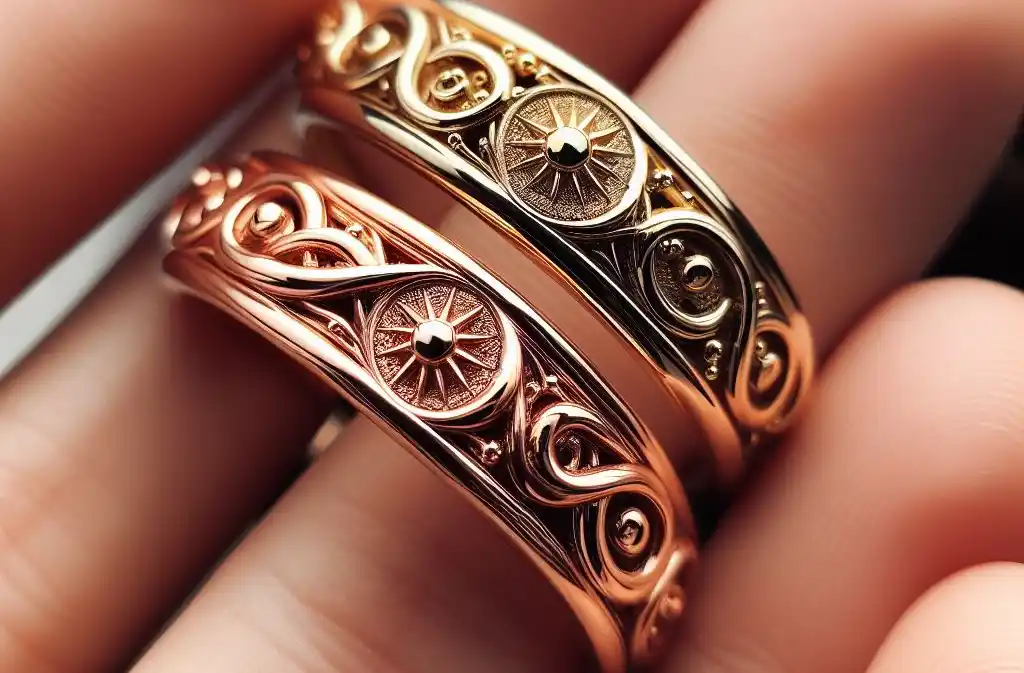
The allure of 10k rose gold largely stems from its robustness. Its composition, rich in copper, lends it superior durability, making it an optimal choice for jewelry that’s meant to withstand daily wear and tear.
This resilience is particularly beneficial for pieces like rings and bracelets, which are more exposed to physical damage. Another significant advantage of 10k rose gold is its affordability.
The reduced gold content results in a lower price point, making it accessible to a wider audience and allowing for the purchase of more substantial pieces without breaking the bank.
However, these benefits come with certain trade-offs. The higher alloy content in 10k rose gold dilutes its gold hue, producing a less intense rose color that might not meet the expectations of those desiring the quintessential pink blush of rose gold.
This muted coloration can affect the overall aesthetic appeal of the jewelry. Additionally, the presence of a larger percentage of copper can potentially increase the likelihood of skin irritation for those with sensitive skin, a factor worth considering for individuals prone to metal allergies.
Pros and Cons Of 14k Rose Gold
14k rose gold is celebrated for its enchanting, rich pink hue that aligns more closely with the traditional image of rose gold, making it highly sought after for high-end jewelry, including engagement rings. This variant’s increased gold content not only imparts a deeper color but also contributes to its prestige and desirability in the market.
It’s a choice that signals a commitment to quality and aesthetic appeal. However, this higher purity brings with it a softer nature compared to its 10k counterpart, rendering it more vulnerable to scratches and damage from everyday wear.
This characteristic necessitates a bit more care and attention to maintain its pristine condition. Additionally, the premium associated with 14k rose gold’s luxurious appearance and higher gold content means it comes with a heftier price tag.
This aspect can make it less accessible to those working within a tight budget or looking for larger, more elaborate pieces without a significant financial outlay. Thus, while 14k rose gold offers an exquisite color and a nod to luxury, it requires careful consideration of its delicate nature and cost implications.
Color Differences Between 10k and 14k Rose Gold
One of the most striking distinctions when comparing 10k and 14k rose gold is their color variance. 10k rose gold, with its substantial copper content, presents a lighter, sometimes more reddish tone, deviating from the classic rose gold hue many expect.
This variation often leads to a more subdued rose appearance, which might appeal to those looking for a less traditional color scheme in their jewelry. In contrast, 14k rose gold boasts a higher percentage of gold, culminating in a deeper and more vibrant pink that aligns with the iconic rose gold color.
This richer hue not only enhances the visual appeal of the jewelry but also contributes to its perception as a more premium option. The color difference is pivotal for buyers, as it significantly influences the aesthetic and character of the jewelry, shaping its overall impact and the message it conveys.
Durability and Wearability
In the realm of durability and wearability, 10k rose gold takes the lead, attributed to its robust composition. The higher percentage of copper and other metals in 10k rose gold not only fortifies its structure but also enhances its resistance to the rigors of daily use.
This makes it an ideal choice for jewelry pieces like engagement rings and bracelets, which are prone to frequent contact and potential abrasion. Conversely, 14k rose gold, with its greater gold content, offers a softer constitution.
While it still maintains a good level of durability, it is more susceptible to scratches and dents compared to its 10k counterpart. This delineation in physical resilience underscores the importance of considering lifestyle and usage habits when selecting between the two, ensuring the longevity and lasting beauty of the chosen piece.
Price Comparison of 10k vs 14k Rose Gold
The economic aspect plays a significant role when selecting between 10k and 14k rose gold, directly linked to their gold content. Naturally, 10k rose gold presents a more budget-friendly option due to its lower gold percentage, appealing to those looking for affordability without compromising on the allure of rose gold jewelry.
This cost-effectiveness allows purchasers the flexibility to opt for larger or more complex designs at a fraction of the price. Conversely, 14k rose gold, with its higher gold content, commands a premium. This elevated price point is reflective of its deeper, more vibrant color and the perceived value associated with its purity.
It caters to buyers placing a higher emphasis on the jewelry’s aesthetic qualities and long-term value, rather than upfront cost. Thus, the decision between 10k and 14k rose gold involves balancing the initial investment with personal preferences for color intensity and gold purity.
Hypoallergenic Properties
For those with sensitive skin, the choice between 10k and 14k rose gold is not merely aesthetic but a matter of comfort and health. Both varieties of rose gold incorporate copper, known for its potential to irritate sensitive skin.
This is where the gold content becomes particularly relevant; 14k rose gold, with its higher gold to copper ratio, generally poses a lower risk of causing allergic reactions. This is due to its decreased alloy content, which includes metals that can be irritants for some individuals.
While no metal can be guaranteed to be completely hypoallergenic, the composition of 14k rose gold offers a better alternative for wearers prone to allergies.
The reduced alloy content in 14k rose gold makes it a safer option for those concerned about skin sensitivity, ensuring the joy of wearing rose gold jewelry isn’t marred by discomfort.
It’s advisable for individuals with known metal sensitivities to lean towards 14k rose gold to mitigate potential allergic reactions, making their jewelry experience as pleasurable as possible.
Resale Value: 10k vs 14k Rose Gold
When considering the long-term financial aspects of your rose gold jewelry, the resale value is an important factor. Typically, 14k rose gold holds a stronger position in the resale market due to its higher gold content. This elevated purity not only enhances its immediate visual and tactile appeal but also contributes to its enduring value.
Buyers in the secondary market often lean towards pieces that showcase a richer, more vibrant color, and 14k rose gold fits this bill perfectly, thereby attracting higher offers.
On the other hand, while 10k rose gold may initially be more cost-effective, its lower gold content can translate to a reduced return upon resale.
The market perceives 14k rose gold as a more luxurious and desirable commodity, which is reflected in its stronger resale performance. This disparity in resale value between the two karat options is an essential consideration for those viewing their purchase as a long-term investment.
10k vs 14k Rose Gold: Which Is Better?
Deciding which is better between 10k and 14k rose gold isn’t about one being universally superior to the other; it’s about which option better aligns with your specific needs and values. If your priority is durability and cost-efficiency, 10k rose gold stands out as the ideal choice.
Its robustness suits an active lifestyle and offers great value for those seeking the beauty of rose gold on a budget. On the flip side, if you’re drawn to the allure of a richer, more vibrant pink color and have concerns about skin sensitivity, 14k rose gold may be the preferable option.
This choice leans towards those valuing aesthetic richness and hypoallergenic properties, even if it means a higher upfront cost.
Essentially, the “better” option is the one that best satisfies your criteria for beauty, wearability, and budget, making the selection a highly individualized decision.
Making the Right Choice for Your Jewelry
When deciding whether 10k or 14k rose gold suits your needs best, several considerations come into play. For individuals looking for jewelry that can withstand daily wear while being mindful of their budget, 10k rose gold emerges as a compelling choice.
Its enhanced durability and lower cost make it suitable for larger, everyday pieces where the risk of damage is higher. Conversely, for those who value a more pronounced rose gold color and are concerned about skin sensitivities, 14k rose gold offers a more vibrant hue and reduced risk of allergic reactions due to its higher gold content.
This option, while pricier, appeals to those prioritizing aesthetic appeal and hypoallergenic properties, potentially making it a better long-term investment.
Reflect on your lifestyle, the importance of color and material purity in your jewelry, and how much you’re willing to spend. This thoughtful consideration will guide you to the rose gold that aligns with your desires, ensuring your chosen piece brings lasting satisfaction and joy.
Conclusion
In summarizing the comparison between 10k and 14k rose gold, the decision is highly personal and depends on a variety of factors.
Whether your priority lies in the durability and cost-effectiveness of 10k rose gold or the richer hue and hypoallergenic properties of 14k rose gold, each type offers distinct benefits that cater to different preferences and requirements.
While 10k rose gold is ideal for those seeking a more budget-friendly option that stands up well to daily wear, 14k rose gold appeals to individuals who place a higher value on color intensity and skin compatibility.
Consideration of lifestyle, aesthetic preferences, and financial willingness will steer you toward the rose gold option that best matches your desires.
The understanding of their differences ensures that your choice not only reflects your personal taste but also meets your practical needs, allowing you to cherish your rose gold jewelry for years to come.
FAQs
Can I wear my rose gold jewelry every day?
Yes, you can wear rose gold jewelry daily, especially if it’s 10k rose gold, known for its durability and resistance to wear and tear. However, 14k rose gold, while slightly softer, can also be worn regularly with a bit of extra care.
Will 14k rose gold fade over time?
Rose gold of any karat can slightly change in color over time due to wear and the natural patina that develops. However, the change is minimal, and proper care can maintain its vibrant hue.
Is there a noticeable difference in color between 10k and 14k rose gold?
Yes, there is. 14k rose gold has a richer, more profound pink color due to its higher gold content, while 10k rose gold has a lighter, more subtle hue.
Are there hypoallergenic options for those with sensitive skin?
While no metal is completely hypoallergenic, 14k rose gold is generally better for sensitive skin due to its higher gold content and reduced alloy mix, which can decrease the risk of skin irritation.
Can the copper in rose gold cause an allergic reaction?
For some individuals, the copper content in rose gold can cause skin irritation. If you have a known copper sensitivity, 14k rose gold may be a more suitable option due to its lower copper percentage.

